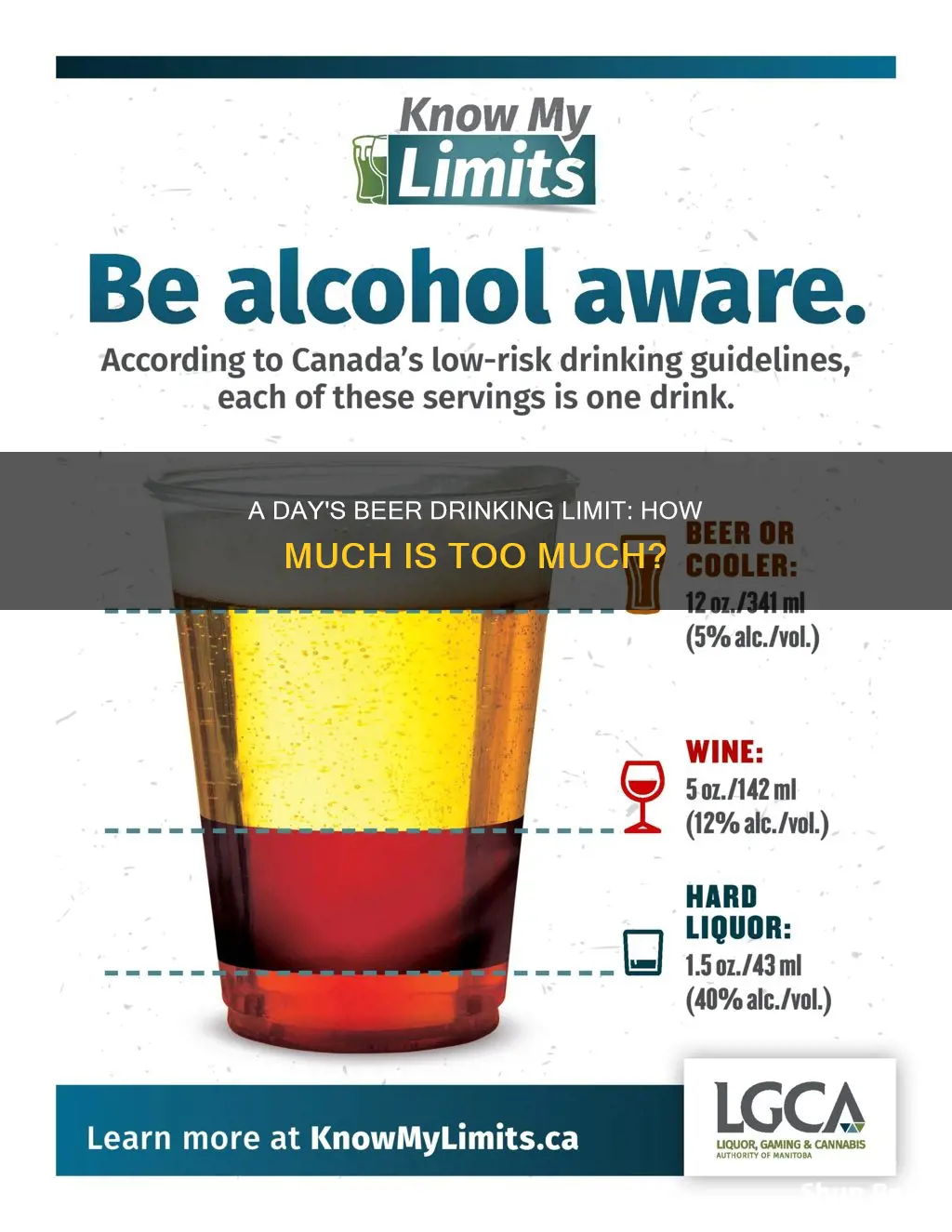
How much beer is too much beer? This is a question that many people, especially those who drink beer regularly, may ask themselves. While beer is often seen as a harmless way to relax, heavy beer consumption can have negative impacts on a person's health, finances, and relationships. Excessive drinking is generally categorised into binge drinking and heavy drinking. Binge drinking is defined as consuming enough alcohol to reach a blood alcohol concentration (BAC) of 0.08% or higher, which for men, is typically five or more drinks within two hours, and for women, is four or more drinks within the same time frame. Heavy drinking is defined as consuming at least eight drinks per week for women and 15 drinks per week for men. The consequences of excessive drinking can include unintentional injuries, violence, risky sexual behaviours, memory and learning problems, chronic diseases such as liver disease and cancer, and a weakened immune system. It is important to note that drinking guidelines vary for different countries and individuals with certain health conditions or medications.
| Characteristics | Values |
|---|---|
| Number of beers considered excessive drinking for men | 5 or more beers in two hours or 15 or more beers a week |
| Number of beers considered excessive drinking for women | 4 or more beers in two hours or 8 or more beers a week |
| Number of beers considered moderate drinking for men | 1-2 beers a day |
| Number of beers considered moderate drinking for women | 1 beer a day |
What You'll Learn

Binge drinking
The risks of binge drinking are not limited to physical health but also extend to mental health. It can worsen existing mental health issues such as depression, anxiety, and other mental health disorders. Binge drinking can also lead to blackouts, where individuals lose all memory of their actions during intoxication.
Young people who binge drink are at particular risk due to their lower familiarity with alcohol's effects and higher likelihood of engaging in impulsive or dangerous behaviours. However, binge drinking is not limited to a specific age group or gender and can affect anyone.
To reduce the risks associated with binge drinking, it is recommended to follow low-risk drinking guidelines, such as limiting alcohol consumption to no more than 14 units per week for both men and women, spread over several days with drink-free days included. Additionally, drinking slowly, consuming alcohol with food, and alternating alcoholic drinks with water can help minimise the negative impacts on health.
If you or someone you know is struggling with binge drinking, there are resources available to help. Seeking support from a healthcare professional or a local community alcohol support service can be a good first step towards managing this behaviour and reducing associated risks.
Breastfeeding and Beer: Is It Safe to Drink?
You may want to see also

Heavy drinking
The National Institute on Alcohol Abuse and Alcoholism (NIAAA) defines heavy drinking as consuming four or more drinks in a day or eight or more drinks per week for women. For men, heavy drinking is defined as consuming five or more drinks in a day or 15 or more drinks per week. Binge drinking, a pattern of drinking that results in a blood alcohol concentration (BAC) of 0.08% or higher, is also considered a form of heavy drinking.
The Substance Abuse and Mental Health Services Administration (SAMHSA) defines heavy drinking slightly differently. For men, they consider heavy drinking to be consuming more than 15 drinks per week, and for women, more than eight drinks per week. SAMHSA also includes binge drinking in its definition of heavy drinking, specifying that it occurs when an individual engages in binge drinking on five or more days in a month.
Engaging in heavy drinking can lead to a higher risk of developing Alcohol Use Disorder (AUD). AUD is characterised by a diminished ability to control alcohol consumption, strong cravings, and continued drinking despite adverse consequences. However, it is important to note that not all heavy drinkers are alcoholics or have AUD. Heavy drinking can still negatively impact an individual's health, relationships, and social life.
The health consequences of heavy drinking are severe and include an increased risk of cardiovascular disease, hypertension, liver damage, stroke, cardiomyopathy, and cancer. Heavy drinking is also associated with a higher risk of unintentional injuries, drunk driving, and illicit drug use.
Beer and Kidney Pain: Is There a Link?
You may want to see also

Alcohol dependence
The amount of beer a person can drink in a day varies depending on factors such as age, gender, weight, height, metabolism, and whether they have eaten. However, it is important to note that drinking alcohol, even in moderate amounts, has been linked to adverse health effects, including an increased risk of breast cancer and stroke. Therefore, the less alcohol consumed, the better.
Signs and Symptoms
- Increased tolerance: Needing more alcohol to achieve the desired effect.
- Priority shift: Giving priority to drinking over other activities or obligations, such as work or family.
- Negative consequences: Continuing to drink despite harmful consequences, such as liver disease or depression.
- Withdrawal symptoms: Experiencing physical and mental withdrawal symptoms when reducing or stopping alcohol consumption.
- Cravings: Intense cravings or a strong internal drive to consume alcohol.
- Inability to cut down: Repeatedly trying and failing to reduce alcohol intake.
- Impaired functioning: Alcohol interfering with work, family, or social obligations.
- Risky behaviour: Engaging in risky behaviours while under the influence, such as driving or operating machinery.
- Health issues: Continuing to drink despite having a medical condition or mental disorder exacerbated by alcohol.
Causes and Risk Factors
- Early drinking: Individuals who start drinking at a young age are at a higher risk of developing alcohol dependence.
- Genetics and family history: Genetics play a significant role, and a family history of alcohol problems increases the likelihood of developing alcohol dependence.
- Mental health: Co-occurring mental health conditions, such as depression, post-traumatic stress disorder (PTSD), or attention-deficit/hyperactivity disorder (ADHD), can increase the risk.
- Trauma: Experiencing childhood trauma or other traumatic events can make individuals more vulnerable to alcohol dependence.
- Environmental factors: The society one lives in, including the availability and cost of alcohol, and peer pressure, can influence the development of alcohol dependence.
Health Risks and Complications
- Liver disease: Prolonged heavy drinking can damage the liver, with alcoholic liver disease commonly seen in dependent drinkers.
- Cancer: Increased risk of cancers of the mouth, throat, breast, bowel, and pancreas.
- Cardiovascular issues: Alcohol can cause high blood pressure, stroke, and alcohol-related heart disease.
- Mental health: Alcohol dependence is associated with poor mental health, including anxiety, depression, and suicidal thoughts.
- Relationship and social issues: Alcohol dependence can negatively impact relationships with partners, family, and friends, and affect work and financial stability.
- Aggression: Alcohol can increase aggression, potentially leading to unsafe situations.
Treatment and Support
Treatment for alcohol dependence typically includes a combination of medication and behavioural therapy:
- Medication: Drugs such as naltrexone, acamprosate, and disulfiram are approved to help reduce cravings and prevent relapse.
- Behavioural therapy: Counselling and talk therapy aim to change drinking behaviour and develop coping strategies.
- Support groups: Mutual-support groups, such as Alcoholics Anonymous, provide peer support and can be valuable during recovery.
- Inpatient treatment: For severe cases, inpatient medical treatment or residential rehabilitation may be recommended.
Prevention and Harm Reduction
- Regular breaks: Taking regular breaks from alcohol is essential to lower the risk of developing alcohol dependence.
- Reducing consumption: With support and motivation, individuals can cut down their alcohol intake to lower-risk levels.
- Medical advice: It is crucial to seek medical advice before stopping alcohol consumption, especially for dependent drinkers, to ensure a safe withdrawal process.
The Perfect Combo: Beer-Rita Sipping Guide
You may want to see also

Health consequences
The amount of beer a person can drink in a day depends on various factors, including their weight, height, metabolism, and other health factors. While some people may be able to consume more than others, drinking excessive amounts of beer can lead to serious health consequences. Here are some detailed paragraphs on the potential health consequences of drinking too much beer:
Liver Disease
Excessive alcohol consumption is a major cause of liver disease. Drinking more than two to three 12-ounce (355 ml) bottles of beer per day can increase the risk of liver diseases such as cirrhosis, which is a life-threatening condition characterised by scarring of the liver. Alcoholic hepatitis, another potential consequence, is an inflammation of the liver caused by excessive drinking.
Increased Risk of Certain Cancers
Research has linked alcohol consumption to an increased risk of various cancers, including throat and mouth cancers. Even light to moderate drinking has been associated with a higher risk of certain cancers. The risk increases with heavier drinking.
Weight Gain
A standard 12-ounce (355 ml) beer contains around 153 calories. Consuming multiple drinks can contribute to weight gain over time. Additionally, alcohol can hinder muscle growth and recovery, further impacting overall weight management.
Depression
Heavy and binge drinking are associated with a significantly higher risk of depression compared to moderate drinkers and non-drinkers. Research suggests a link between excessive alcohol consumption and an increased likelihood of developing depression.
Alcohol Dependence and Alcohol Use Disorder
Frequent alcohol consumption can lead to alcohol dependence and alcohol use disorder (AUD). AUD is a chronic health problem characterised by a strong craving for alcohol, a loss of control over drinking, and negative emotions when not drinking. Heavy drinking, especially when it becomes a regular occurrence, can increase the risk of developing AUD.
Increased Risk of Death
Heavy and binge drinkers have a higher risk of early death compared to moderate drinkers and non-drinkers. Excessive alcohol consumption is associated with an increased likelihood of premature mortality.
Cardiovascular Issues
While light to moderate drinking may have some cardiovascular benefits, heavy drinking can increase the risk of heart disease and stroke. Excessive alcohol consumption can lead to cardiomyopathy, which is a condition that damages the heart muscle. It can also increase blood pressure and cause irregular heartbeats.
Other Health Issues
Excessive beer consumption can lead to various other health issues, including high blood pressure, insomnia, gout, and neurological conditions. It can also worsen existing health problems, such as liver disease, asthma, and gastroesophageal reflux disease (GERD). Additionally, drinking alcohol while taking certain medications can lead to dangerous interactions and exacerbate existing health conditions.
Beer and Diarrhea: What You Need to Know
You may want to see also

Social and professional consequences
Excessive alcohol consumption can have a range of social and professional consequences. Here are some key impacts to consider:
Social Consequences:
- Family and Relationships: Drinking can impair an individual's ability to perform their role as a parent or partner and contribute to the functioning of their household. It can lead to child abuse, neglect, and adverse effects on the social, psychological, and economic environment of their children. Alcohol is also linked to domestic violence, with studies showing that a significant fraction of reported domestic violence incidents involve alcohol use by one or both partners.
- Community: Heavy drinking is associated with community disorganization and violence. Studies suggest that minority communities have higher concentrations of liquor stores, potentially increasing access to alcohol among these populations. Living in disadvantaged neighborhoods, with higher alcohol outlet densities, and witnessing drug dealing and peer drinking are all associated with increased alcohol consumption.
- Health: Excessive alcohol consumption is linked to various health issues, including liver disease, cardiovascular disease, weight gain, memory loss, mental health issues such as anxiety and depression, and an increased risk of certain cancers.
- Economic: Alcohol abuse can lead to economic problems, with heavy drinkers facing lower wages, lost employment opportunities, increased medical and legal expenses, and decreased eligibility for loans. This can result in financial strain for individuals and their families, affecting their ability to meet basic needs and contribute to household income.
Professional Consequences:
- Work Performance and Unemployment: Alcohol dependence and drinking problems are linked to increased absenteeism and a higher risk of work accidents, resulting in decreased productivity. Heavy drinking or alcohol abuse may also lead to unemployment, and unemployment itself can contribute to increased drinking.
- Legal Issues: Alcohol is often a factor in legal issues and criminal justice involvement, with drinking linked to a higher risk of accidents, violence, and other social harms.
- Healthcare Costs: The economic impact of alcohol abuse includes increased healthcare costs for individuals and society, with resources needed for medical treatment, rehabilitation, and long-term care for alcohol-related health issues.
It's important to note that these consequences can vary based on individual factors, cultural norms, and societal influences. The impact of alcohol consumption is complex and far-reaching, affecting not only the drinker but also their families, communities, and society as a whole.
Beer and Cipro: Is It Safe to Drink Alcohol?
You may want to see also
Frequently asked questions
The recommended daily limit of alcohol consumption for men is two drinks or less, and for women, it is one drink or less. These amounts are not intended as an average but rather as a daily limit.
Excessive drinking is categorised into two types: binge drinking and heavy drinking. Binge drinking is consuming enough alcohol to raise one's blood alcohol concentration (BAC) to 0.08% or higher. For men, this typically occurs after five or more drinks within two hours, and for women, it is four or more drinks within two hours. Heavy drinking is defined as consuming eight or more drinks per week for women and 15 or more drinks per week for men.
Excessive drinking can lead to an increased risk of several health issues, including unintentional injuries, violence, risky sexual behaviours, memory and learning problems, early dementia, tissue and organ damage, chronic diseases (such as liver disease, heart disease, stroke, high blood pressure, and cancer), gastrointestinal issues, malnourishment, a weakened immune system, obesity, depression, and anxiety.
Alcohol use disorder (AUD) is characterised by an inability to control or stop drinking despite experiencing negative consequences. It involves excessive drinking, which can lead to alcohol dependence and severe health issues.







